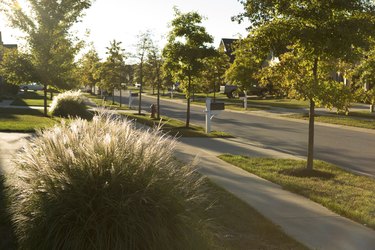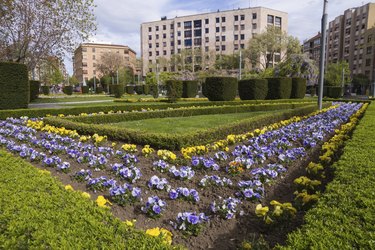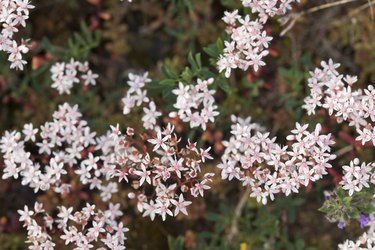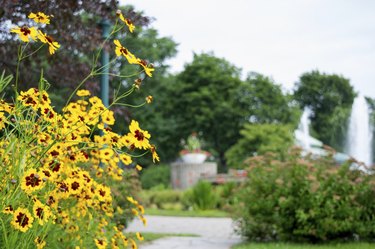
Whether you're landscaping around an ornamental lamppost in your garden or adding a decorative touch to a lamppost on the verge outside your home, selecting plants for the site can be challenging. The concrete foundations that give a lamppost stability create shallow, dry growing conditions, and a roadside site can be exposed to air pollution from car exhaust. Before planting, loosen the soil as deeply as possible with a garden fork and mix in 3 to 4 inches of compost.
Watch the Grass Grow
Video of the Day

Drought-tolerant ornamental grass around a lamppost in a lawn provides a grassy variation and doesn't require mowing. Blue grama (Bouteloua gracilis) forms dense, bluish-gray clumps 9 to 24 inches tall and 18 to 24 inches wide. Also called mosquito grass, this perennial grass bears arching stems of purplish-tinged flowers in early summer followed by curved seed spikes on golden-brown fall stems, and grows in U.S. Department of Agriculture plant hardiness zones 3 through 10. Blue fescue (Festuca glauca) forms domes of needlelike, bluish-gray foliage 9 to 12 inches tall and 12 to 18 inches wide. Hardy in USDA zones 4 through 8, blue fescue bears purple-tinged, light green late spring through early summer, and buff seed heads.
Video of the Day
Hedge It In

A neat, flowering hedge around a lamppost complements its simple, formal shape. English lavender "Hidcote" (Lavandula angustifolia "Hidcote"), which grows in USDA zones 5 through 8, grows in mounds 12 to 18 inches tall and wide, and bears spikes of fragrant, deep purple, summer flowers. Smooth hydrangea Endless Summer Bella Anna (Hydrangea arborescens "Piiha-I" Endless Summer Bella Anna) grows in USDA zones 4 through 9, and grows 24 o 36 inches tall and wide. Bearing magenta-pink, mop-head flowers, Bella Anna flowers on new and old wood, resulting in prolific flowering all summer. Both shrubs grow in shallow, rocky soil.
Rely on Perennials

Perennials liven up the area around a lamppost reliably, year after year. White stonecrop "Coral Carpet" (Sedum album "Coral Carpet") bears clusters of tiny white or pale pink early summer flowers. New foliage emerges salmon-orange in spring, matures to bright green in summer and fades to reddish-bronze in winter. "Coral Carpet" grows 3 to 6 inches tall and 6 to 9 inches wide. Black-eyed Susan Viette's Little Suzy (Rudbeckia fulgida "Blovi" Viette's Little Suzy) grows 12 to 18 inches tall and 9 to 12 inches wide, and bears dark-centered, yellow, daisylike flowers midsummer through fall. Both perennials grow in USDA zones 3 through 9 and tolerate shallow, rocky soil and air pollution.
Change It Up

If you prefer an ever-changing display, grow annuals around the lamppost. Plains coreopsis (Coreopsis tinctoria) and globe amaranth "Buddy" (Gomphrena globosa "Buddy") tolerate dry soil and thrive in a full-sun site. Plains coreopsis blooms late spring through fall, bearing yellow daisylike flowers on plants 24 to 48 inches tall and 12 to 18 inches wide. "Buddy" bears deep purple, pompomlike flowers early summer through fall, and grows 12 to 24 inches tall and 6 to 12 inches wide. Sow seeds for both plants indoors six to eight weeks before the average final frost date, or directly in the ground after the last frost.
- Missouri Botanical Garden: Bouteloua Gracilis
- Missouri Botanical Garden: Festuca Glauca
- Missouri Botanical Garden: Lavandula Angustifolia "Hidcote"
- Missouri Botanical Garden: Sedum Album "Coral Carpet"
- Missouri Botanical Garden: Rudbeckia Fulgida "Blovi" Viette's Little Suzy
- Missouri Botanical Garden: Coreopsis Tinctoria
- Missouri Botanical Garden: Gomphrena globosa "Buddy"
- Missouri Botanical Garden: Hydrangea Arborescens "Piiha-I" Endless Summer Bella Anna
- University of California Cooperative Extension Sacramento County: Garden and Landscape Plantings on Hardpan Soils
- Michigan State University Extension: Drought-Tolerant Plants Save Water, Money and Time